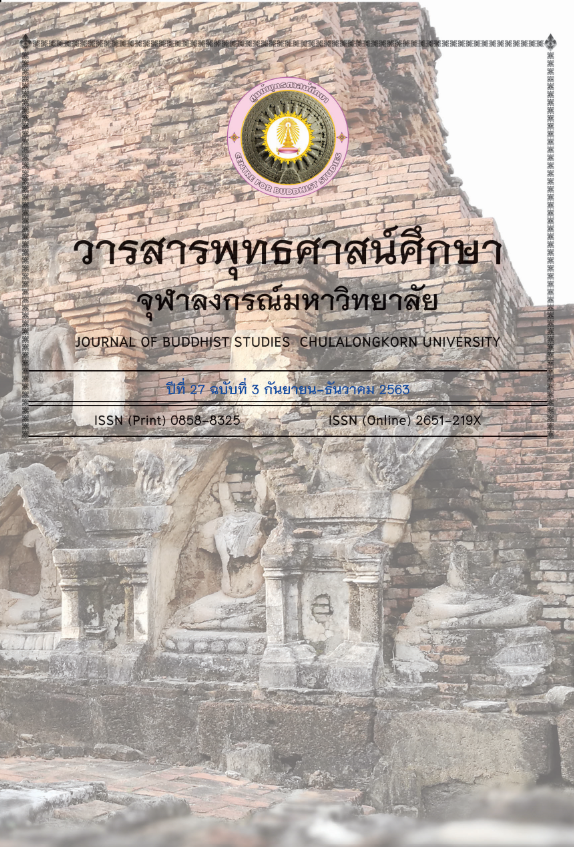Buddhism and Otherness in Thai Films (1997-2017)
Keywords:
Buddhism, Otherness, Thai FilmsAbstract
The main objective of this research article is to analyze the depiction of Buddhism and otherness in Thai films from 1997 to 2017. The 5 films selected for discussion by using textual analysis approach are: Nang Nak (Nonzee Nimibutr, 1999), Mekhong Full Moon Party (Jira Maligool, 2002), OK Baytong (Nonzee Nimibutr, 2003), Pee Mak (Banjong Pisanthanakun, 2013) and Wandering (Boonsong Nakphoo, 2016). This study offers the following key points. 1) In most of these films, women are represented as “the other” of Thai Buddhism. As monks hold the highest status in Thai Buddhist culture, it seems that most Thai Buddhists are under the sway of the belief that “Women are an enemy to the life of purity”. 2) Otherness is, in itself, a form of cultural violence which can be used to justify or legitimize direct and/or structural violence. And 3) Communication can be the key for mitigating otherness as it can help prevent conflicts and increases the chances of possible understanding of others.
Downloads
References
กำจร หลุยยะพงศ์และสมสุข หินวิมาน. (2552). หลอน รัก สับสน ในหนังไทย: ภาพยนตร์ไทยในรอบสามทศวรรษ (พ.ศ. 2520-2547): กรณีศึกษาตระกูลหนังผี หนังรัก และหนังยุคหลังสมัยใหม่. กรุงเทพมหานคร: ศยาม.
กำจร หลุยยะพงศ์. (2556). ภาพยนตร์กับการประกอบสร้างสังคม ผู้คน ประวัติศาสตร์ และชาติ. กรุงเทพมหานคร: สำนักพิมพ์แห่งจุฬาลงกรณ์.
ธงชัย วินิจจะกูล. (2560). คนไทย / คนอื่น : ว่าด้วยคนอื่นของความเป็นไทย. นนทบุรี : ฟ้าเดียวกัน.
บุญรักษ์ บุญญะเขตมาลา. (2538). ศิลปะแขนงที่เจ็ด. กรุงเทพมหานคร: อมรินทร์.
สมชาย ปรีชาศิลปกุล และนัทมน คงเจริญ. (2545) การยอมรับ/กีดกันชาวเขาในกระบวนการให้สัญชาติไทย: สำรวจข้อกฎหมาย แนวนโยบาย สภาพปัญหา. เชียงใหม่: โครงการจัดตั้งภาควิชานิติศาสตร์ คณะสังคมศาสตร์ มหาวิทยาลัยเชียงใหม่.
อัญชลี ชัยวรพร. (2559) ภาพยนตร์ในชีวิตไทย: มุมมองของภาพยนตร์ศึกษา. กรุงเทพมหานคร: สำนักพิมพ์ วราพร.
พฤทธิสาณ ชุมพล, ม.ร.ว. (2546) “identity อัตลักษณ์ ตัวตน.” ใน คำและความคิดในรัฐศาสตร์ร่วมสมัย. กรุงเทพมหานคร: สำนักพิมพ์แห่งจุฬาลงกรณ์มหาวิทยาลัย.
ชัยรัตน์ พลมุข. (2016). [บทวิจารณ์หนังสือ Ghostly Desires: Queer Sexuality and Vernacular Buddhism in Contemporary Thai Cinema by Arnika Fuhrmann]. Journal of Mekong Societies, 12(3), 187-198.
สุรสม กฤษณะจูฑะ. (2547). การเมืองวัฒนธรรมของความเป็นอื่นในพื้นที่สื่อ: การต่อสู้ทางวาทกรรมว่าด้วยพลังงาน. (วิทยานิพนธ์ปริญญาศิลปศาสตรมหาบัณฑิต สาขาวิชาการพัฒนาสังคม มหาวิทยาลัยเชียงใหม่).
จิระ มะลิกุล. (ผู้กำกับ). (2545). 15 ค่ำ เดือน 11. [ภาพยนตร์]. กรุงเทพมหานคร: จีเอ็มเอ็ม พิคเจอร์, หับ โห้ หิ้น ฟิล์ม.
นนทรีย์ นิมิบุตร. (ผู้กำกับ). (2542). นางนาก. [ภาพยนตร์]. กรุงเทพมหานคร: ไท เอ็นเตอร์เทนเมนต์.
นนทรีย์ นิมิบุตร. (ผู้กำกับ). (2546). โอเค เบตง. [ภาพยนตร์]. กรุงเทพมหานคร: สหมงคลฟิล์ม.
บรรจง ปิสัญธนะกูล. (ผู้กำกับ). (2556). พี่มาก...พระโขนง. [ภาพยนตร์]. กรุงเทพมหานคร: จอกว้าง ฟิล์ม.
บุญส่ง นาคภู่. (ผู้กำกับ). (2559). ธุดงควัตร. [ภาพยนตร์]. กรุงเทพมหานคร: ปลาเป็นว่ายทวนน้ำ สตูดิโอ.
Bauman, Zygmunt. (1998). Modernity and Ambivalence. Cambridge: Polity Press.
Gönül, Dönmez-Colin. (2006). Cinemas of the Other: A Personal Journey with Film-makers from the Middle East and Central Asia. Bristol: Intellect.
Galtung, Johan. (1996). Peace by Peaceful Means: Peace and Conflict, Development and Civilization. Oslo: International Peace Research Institute.
Monaco, James. (2009). How to Read a Film: Movies, Media, and Beyond. Oxford: Oxford University Press.
Polyakov, Emma O’Donnell. (2018). Antisemitism, Islamophobia, and Interreligious Hermeneutics: Ways of Seeing the Religious Other. Leiden: Brill.
Richardson, Michael. (2010). Otherness in Hollywood Cinema. New York: Continuum.
Rose, Gillian. (2016). Visual Methodologies: An Introduction to Researching with Visual Materials. (4th ed.). London: SAGE.
Downloads
Published
How to Cite
Issue
Section
License
บทความที่ได้รับการตีพิมพ์เป็นลิขสิทธิ์ของศูนย์พุทธศาสน์ จุฬาลงกรณ์มหาวิทยาลัย
ข้อความที่ปรากฏในบทความแต่ละเรื่องในวารสารวิชาการเล่มนี้เป็นความคิดเห็นส่วนตัวของผู้เขียนแต่ละท่านไม่เกี่ยวข้องกับศูนย์พุทธศาสน์ จุฬาลงกรณ์มหาวิทยาลัย และคณาจารย์ท่านอื่นๆในมหาวิทยาลัยฯ แต่อย่างใด ความรับผิดชอบองค์ประกอบทั้งหมดของบทความแต่ละเรื่องเป็นของผู้เขียนแต่ละท่าน หากมีความผิดพลาดใดๆ ผู้เขียนแต่ละท่านจะรับผิดชอบบทความของตนเองแต่ผู้เดียว






